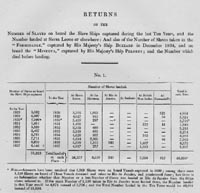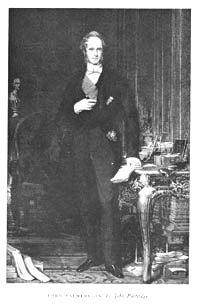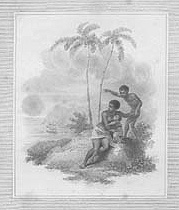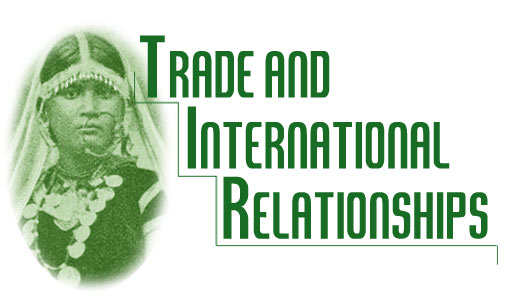
The
trans-Atlantic slave trade had a long, busy life until 1817 when an
international body, the Mixed Courts of Justice, was created to pursue treaties
between states to put a stop to it. It
had slowed down since 1807 when the United States made it illegal and 1808 when it
was banned in the British Empire. The Spaniards
were allowed to trade south of the equator until May 20,
1820;
however, they engaged in the slave trade much longer than that. Cuba was the main destination of the
illegal slave trade and thousands of Africans were brought there, despite
British efforts to stop the trade and knowledge of its existence by Cuban
authorities.
Cuba participated in many types of trade,
and traded with countries all over the world.
While slaves were brought from Africa, linen, cotton fabrics, glass, and ironware were brought
from Northern
Europe;
and food and lumber were coming from the United States.
Surprisingly, Cuba did not have many relations with
Spanish America.
The United States saw Cuba’s potential and tried to annex it;
and when speaking of ways to fend off the United States, Lord Palmerston,
a British official in charge of relations with Cuba, said that “if the
Negro population of Cuba were rendered free, that fact would create
a most powerful element of resistance to any scheme for annexing Cuba
to the United States”.
[1]
According to Blackburn, there were about 217,000 slaves
and 109,000 free people of color in Cuba around this time.
[2]
The slave population kept growing even after
1820 when trade was supposed to stop, and the leaders of Cuba knew it was because of the illegal
trade but they did nothing to stop it.
They suggested that they ask the United Stated for help with
battling the slave trade. Many
powerful Cuban sugar growers opposed interdiction of the illegal trade
because they believed that if the slave trade actually stopped, the
slave population would drop rapidly and there would be no one left to
work the plantations.
[3]
Strictly looking at numbers, 372,449 slaves
were imported to Cuba  before
the slave trade legally ended, and at least 123,775 were imported between
1821 and 1853.
[4]
The system used to suppress the slave trade,
if there was any real system, was not very effective in Cuba.
before
the slave trade legally ended, and at least 123,775 were imported between
1821 and 1853.
[4]
The system used to suppress the slave trade,
if there was any real system, was not very effective in Cuba.
Great Britain actively pursued the extinction of
the slave trade to Cuba.
Repeated publications in the Parliamentary
Papers that addressed the suppression of the slave trade. The
British government knew that the slave trade was still going on after
1820, and they noticed that a large majority of the vessels that came
to Havana with slaves were flying the Portuguese
flag, especially in 1836. In
1837 sixty-seven ships came flying the Portuguese flag; and in 1838,
between May and July, nine ships came that had Portuguese papers. Great Britain suggested that they come to an agreement
with Portugal to stop this, but the treaty was
never written because many of the ships flying the Portuguese flag were
not from Portugal.
The Portuguese flag was a great commodity for the slave traders
because with it they basically had a right of passage to Cuba.
Since Brazil, where the slave trade continued
for many years, was first a colony and then an island of Portugal, many slave trading ships flying
the Portuguese ships flag moved through the Atlantic.
For instance, Joze Mazorra
was a well-known trader who would supply owners of slave vessels with
Portuguese papers and send them to Cape de Verde or to the coast of
Africa.
And Chevalier Rebello de Carvalho
of Portugal, protecting Portuguese claims to their own sovereignty,
told Lord Palmerston in 1838 that until a new treaty was reached between
the two states for the total abolition of the slave trade, the Portuguese
government could not acknowledge that British cruisers had any right
to detain Portuguese ships engaged in the slave trade south of the equator.
[5]
The British Minister at Lisbon concluded that only through British
efforts would the abuse of the Portuguese flag stop, and more importantly
the slave trade. A British consulate
in Havana suggested in a letter
[6]
that the British naval force be sent to the coast
of Africa to keep large slave vessels from
getting through; and although some ships went there, they had little
affect.
In
1838, Mr. Tolme, a British consulate in Havana, acknowledged in a letter to Parliament
that the African slave trade to Cuba continued. Tolme was most interested
in trying to keep them out of Cuba, not because it was illegal, but
because these slaves brought with them the notion of freedom, which
could be dangerous. At the end
of September in 1838 about five hundred slaves arrived on two vessels. Mr. Tolme also had
information about other ships engaged in the slave trade, such as the
American ship Sarah M. of Savannah,
which was to hold a cargo of two hundred slaves; the Spanish brig
Manso that left for Africa in June
of 1838 and was to bring back five hundred slaves; and the Dolphin, a schooner expected to bring back
three hundred slaves.
[7]
Mr. Tolme also had
the name of a famous slave trader based in Europe, Jose Miguel Fernandez.
 Lord
Palmerston had more to say on the topic of the illegal slave
trade then anyone else in Cuba.
He suggested that a British Consular agent be established in
Puerto Rico to put a stop to the trade there.
He also requested that the Spanish government order Spanish colonial
authorities to affix a penalty for the offense, and to do this publicly
to get the attention of the people. In response to Palmerston,
British authorities pointed out more shortcomings of the existing system
to stop the slave trade. The
reason why slaves kept being imported is because the demand for slaves
was still high. In May, June,
and July of 1838, no less than 25 vessels sailed for Africa from Havana, some of them having stolen or forged
papers. The Queen was getting
irritated because no one was obeying the government and everyone was
telling someone else to take action against the trade, so the Duke of
Frias was put in charge of giving instructions to the Captain-General
of Cuba for suppression of the slave trade.
Several ships were caught with slaves on them, such as the Eliza,
Esplorador, and Irene;
but one ship was tracked through its journey, and it shows how ships
carried slaves and goods in order to move back and forth between Cuba and Africa.
Around July or August in 1838 the Boca
Negra sailed from Cadiz and brought 250 slaves to Havana, then sailed to Trinidad to pick up sugar bound for Cadiz, and in October the ship was preparing
to sail back to the coast of Africa under a new name, Emprendedor. This was a typical route that a slave vessel
would follow so that they could pretend that they carried goods and
not slaves.
Lord
Palmerston had more to say on the topic of the illegal slave
trade then anyone else in Cuba.
He suggested that a British Consular agent be established in
Puerto Rico to put a stop to the trade there.
He also requested that the Spanish government order Spanish colonial
authorities to affix a penalty for the offense, and to do this publicly
to get the attention of the people. In response to Palmerston,
British authorities pointed out more shortcomings of the existing system
to stop the slave trade. The
reason why slaves kept being imported is because the demand for slaves
was still high. In May, June,
and July of 1838, no less than 25 vessels sailed for Africa from Havana, some of them having stolen or forged
papers. The Queen was getting
irritated because no one was obeying the government and everyone was
telling someone else to take action against the trade, so the Duke of
Frias was put in charge of giving instructions to the Captain-General
of Cuba for suppression of the slave trade.
Several ships were caught with slaves on them, such as the Eliza,
Esplorador, and Irene;
but one ship was tracked through its journey, and it shows how ships
carried slaves and goods in order to move back and forth between Cuba and Africa.
Around July or August in 1838 the Boca
Negra sailed from Cadiz and brought 250 slaves to Havana, then sailed to Trinidad to pick up sugar bound for Cadiz, and in October the ship was preparing
to sail back to the coast of Africa under a new name, Emprendedor. This was a typical route that a slave vessel
would follow so that they could pretend that they carried goods and
not slaves.
Parliament
later proposed a uniform set of punishments for all those captured on
the high seas while engaged in the illegal slave trade.
[8]
There were seven punishments listed:
1.
Captain,
Master, Pilot and Crew of any Spanish vessel involved will be found guilty of
piracy and be sentenced to ten years at the galleys.
2.
Captain,
Master, Pilot and Crew of a vessel being prepared to pick up slaves will serve
two years in prison if they have not left port.
If they are at sea but have not done anything involved with the slave
trade yet, they will be sentenced to four years at the galleys. If negotiations have taken place for the
purchase of slaves, they will spend six years at the galleys.
3.
The
owner(s) of a vessel engaged in the slave trade will be punished like the
Captain, unless they can prove that the object they proposed for the vessel did
not involve slave trade, and the object and cargo of the vessel changed after
her departure from port.
4.
The
purchaser of African Negroes will be sentenced to six years at the galleys.
5.
The
owner(s) of a vessel that knowingly equip her for another fitter-out to go on a
voyage to Africa will suffer half the punishment to
be indicted on the fitter-out.
6.
All
African Negroes are declared free when landing in Spanish possession.
7.
Crimes
against Africans on ships will be punished with penalties established by Spanish
laws against such offenses when committed against free white Christian
peoples.)[9]
These
consequences, if implemented, could have helped stop the slave trade. However, keep in mind that this list of
punishments came from Britain, but the punishments were supposed
to be implemented in Spanish territories.
The Spanish government would not let the sovereignty of their government
be challenged, so they seldom enforced these punishments.
We
have examined Britain’s involvement in the suppression
of the slave trade, but now we take a look from inside Cuba.
Before 1835, the slaves that were taken by traders illegally
were delivered to the Spanish authorities of Cuba and they were liberated from slavery.
The governor was put in charge of these people in order to protect
their rights when they went through apprenticeship, but that is often
not what took place. When the Captain-General of Cuba received the slaves, he sold them
to planters in Cuba, usually for a term of seven years
but most likely forever. General
Tacon was one of the leaders in Cuba who took part in this activity.
It turned  out
that the slaves who were freed after arriving to Cuba and then resold were treated much
worse then the slaves who had been there the whole time. This illegal trade seemed to have been tolerated
by the Cuban government. Mr.
Kilbee, the chief commissioner at Havana, said in the late 1830’s that the
present system to suppress illegal trade was not working and that the
trade was more extensive then it had ever been.
He said that the people of Cuba knew that it was going on but did
nothing about it, like the treaty of 1817 did not exist. Most authorities in Cuba agreed,
everyone knew that the efforts to suppress the slave trade were not
working. In 1835, eighty ships
arrived for illegal trade, and 78 flew the Portuguese flag. It was estimated that there were about 300 slaves
per ship, which have a high monetary value. When there was so much money to be had in this
business it was hard not to get involved, even the French participated.
Finally, on January
18, 1831,
the Board of Trade addressed Lord Palmerston
calling for stronger measures of suppression, and their suggestions
included allocating over a quarter million dollars a year for anti-slavery
efforts. This suggestion was obviously not something
Cuba could afford, and along with other
suggestions was out of the question.
out
that the slaves who were freed after arriving to Cuba and then resold were treated much
worse then the slaves who had been there the whole time. This illegal trade seemed to have been tolerated
by the Cuban government. Mr.
Kilbee, the chief commissioner at Havana, said in the late 1830’s that the
present system to suppress illegal trade was not working and that the
trade was more extensive then it had ever been.
He said that the people of Cuba knew that it was going on but did
nothing about it, like the treaty of 1817 did not exist. Most authorities in Cuba agreed,
everyone knew that the efforts to suppress the slave trade were not
working. In 1835, eighty ships
arrived for illegal trade, and 78 flew the Portuguese flag. It was estimated that there were about 300 slaves
per ship, which have a high monetary value. When there was so much money to be had in this
business it was hard not to get involved, even the French participated.
Finally, on January
18, 1831,
the Board of Trade addressed Lord Palmerston
calling for stronger measures of suppression, and their suggestions
included allocating over a quarter million dollars a year for anti-slavery
efforts. This suggestion was obviously not something
Cuba could afford, and along with other
suggestions was out of the question.
The
illegal slave trade to Cuba was no secret. The British government and the leaders of Cuba knew about it the whole time it was
going on; and even though they all espoused anti-slavery ideas and claimed
that they wanted to put a stop to the slave trade, no one took action
against it. The British government
sent letters to the leaders of Cuba whining about the illegalities taking
place and nagging them to do something about it, while the leaders of
Cuba were at a loss and had no idea what to do to keep this from happening,
or any strong desire to do so. The
illegal slave trade to Cuba was not something that took place
in secret, but was a well-known trade that was essentially allowed to
continue for many years, until it was finally stopped in the 1860s.
